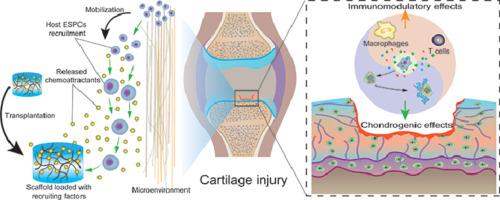Acta Biomaterialia ( IF 9.4 ) Pub Date : 2020-07-08 , DOI: 10.1016/j.actbio.2020.07.008 Zhen Yang 1 , Hao Li 1 , Zhiguo Yuan 2 , Liwei Fu 1 , Shuangpeng Jiang 3 , Cangjian Gao 1 , Fuxin Wang 4 , Kangkang Zha 1 , Guangzhao Tian 1 , Zhiqiang Sun 1 , Bo Huang 4 , Fu Wei 4 , Fuyang Cao 4 , Xiang Sui 4 , Jiang Peng 4 , Shibi Lu 1 , Weimin Guo 5 , Shuyun Liu 4 , Quanyi Guo 1

|
In the absence of timely and proper treatments, injuries to articular cartilage (AC) can lead to cartilage degeneration and ultimately result in osteoarthritis. Regenerative medicine and tissue engineering techniques are emerging as promising approaches for AC regeneration and repair. Although the use of cell-seeded scaffolds prior to implantation can regenerate and repair cartilage lesions to some extent, these approaches are still restricted by limited cell sources, excessive costs, risks of disease transmission and complex manufacturing practices. Recently developed acellular scaffold approaches that rely on the recruitment of endogenous cells to the injured sites avoid these drawbacks and offer great promise for in situ AC regeneration. Multiple endogenous stem/progenitor cells (ESPCs) are found in joint-resident niches and have the capability to migrate to sites of injury to participate in AC regeneration. However, the natural recruitment of ESPCs is insufficient, and the local microenvironment is hostile after injury. Hence, an endogenous cell recruitment strategy based on the combination of chemoattractants and acellular scaffolds to effectively and specifically recruit ESPCs and improve local microenvironment may provide new insights into in situ AC regeneration. This review provides a brief overview of: (1) the status of endogenous cell recruitment strategy; (2) the subpopulations, potential migration routes (PMRs) of joint-resident ESPCs and their immunomodulatory and reparative effects; (3) chemoattractants and their potential adverse effects; (4) scaffold-based drug delivery systems (SDDSs) that are utilized for in situ AC regeneration; and (5) the challenges and future perspectives of endogenous cell recruitment strategy for AC regeneration.
Statement of Significance
Although the endogenous cell recruitment strategy for articular cartilage (AC) regeneration has been investigated for several decades, much work remains to be performed in this field. Future studies should have the following aims: (1) reporting the up-to-date progress in the endogenous cell recruitment strategies; (2) determining the subpopulations of ESPCs, the cellular and molecular mechanisms underlying the migration of these cells and their anti-inflammatory, immunomodulatory and reparative effects; (3) elucidating the chemoattractants that enhance ESPC recruitment and their potential adverse effects; and (4) developing advanced SDDSs for chemoattractant dispatch. Herein, we present a systematic overview of the aforementioned issues to provide a better understanding of endogenous cell recruitment strategies for AC regeneration and repair.
中文翻译:

关节软骨再生的内源性细胞募集策略。
如果没有及时和适当的治疗,关节软骨(AC)的损伤会导致软骨变性,并最终导致骨关节炎。再生医学和组织工程技术正在成为交流再生和修复的有前途的方法。尽管在植入前使用细胞接种的支架可以在一定程度上再生和修复软骨损伤,但是这些方法仍然受到有限的细胞来源,过高的成本,疾病传播的风险和复杂的生产实践的限制。最近开发的脱细胞支架方法依靠将内源性细胞募集到受伤部位避免了这些缺点,并为原位移植提供了广阔前景AC再生。在关节常驻壁ni中发现了多个内源性干/祖细胞(ESPC),它们具有迁移到损伤部位参与AC再生的能力。但是,ESPC的自然募集不足,并且损伤后局部微环境充满敌意。因此,基于化学引诱剂和脱细胞支架相结合的内源性细胞募集策略可以有效,特异性地募集ESPC,并改善局部微环境,这可能为原位提供新的见解。AC再生。这篇综述简要概述了:(1)内源性细胞募集策略的现状;(2)共同居住的ESPC的亚群,潜在迁移途径(PMR)及其免疫调节和修复作用;(3)化学吸引剂及其潜在的不良影响;(4)用于原位AC再生的基于支架的药物递送系统(SDDS);(5)内源性细胞再生AC再生策略的挑战和未来展望。
重要声明
尽管已经研究了用于关节软骨(AC)再生的内源性细胞募集策略,但是在这一领域仍有许多工作要做。未来的研究应具有以下目的:(1)报告内源性细胞募集策略的最新进展;(2)确定ESPC的亚群,这些细胞迁移的基础细胞和分子机制及其抗炎,免疫调节和修复作用;(3)阐明增加ESPC招募的化学吸引剂及其潜在的不良影响;(4)开发先进的SDDS用于化学引诱剂调度。本文中,我们对上述问题进行了系统的概述,以更好地理解AC再生和修复的内源性细胞募集策略。











































 京公网安备 11010802027423号
京公网安备 11010802027423号